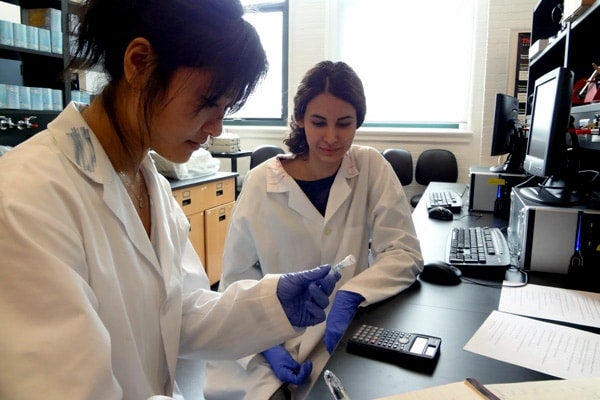
Biomedical engineering students tackle major scientific questions
Published: April 10, 2012
Not many undergraduates can say that their curriculum includes working on a cure for cancer.
But for Rozita Abdola, fourth-year chemical engineering major, and Mengqi Wang, third-year electrical and computer engineering major, it's all part of the program—the Biomedical Engineering undergraduate program.
Recently, students in the Biomedical Instrumentation course at the Institute of Biomaterials and Biomedical Engineering (IBBME) shared the results of their major research projects in a professional poster session at the IBBME teaching laboratories of the Lassonde Mining Building. This professionalization of the scientific process offers students an invaluable learning experience, both in terms of designing and executing large-scale research projects—and its public presentation.
But it was the scope of the students’ experiments that made the course so extraordinary.
Third-year biomedical engineering majors Tara Stratton and Andrea Pagotto looked at ways to amplify and tag DNA sequences of E. Coli bacteria, hoping to discover easier ways for scientists to test for the presence of this deadly bacteria in freshwater samples.
"Our samples weren't conclusive enough," Stratton and Pagotto noted. "But the methods we used showed promise."
Richard Gao and Om Bhatt, third-year engineering science majors, studied the adverse effects of electrical fields on embryonic stem cells. Like others in the course, they noted a similar number of errors discovered over the span of the experiment. But their results were still on target.
"Basically, don’t talk so much on your cell phone," Gao said of their findings, which saw many of the stem cells die off when exposed to amplified electrical fields similar to that of cellular phone technology.
Unlike courses where the right answer is the only answer, courses that include major design projects allow students to learn through trial and error— like real scientists. And, although the vast majority of the students were pleased with the outcome of their experiment, many noted the need to "significantly reduce the number of errors" made in their processes.
For Abdola and Wang, though, frustrating results still hold value. Their project, an examination of "hela" or cervical cancer cells under stress, initially had a much broader scope—finding new ways to tackle the disease on the cellular level.
"We're arriving at a better understanding of the hela cell line," Wang said. "And the information we're gathering can be used by other researchers."
The projects are “a truly remarkable affirmation of the fact that theory is best learnt when our students have the opportunity to apply their classroom knowledge to real world engineering challenges that have the potential for impact," said Professor Paul Santerre, IBBME director."That's what our students have aspired to in this course.”



